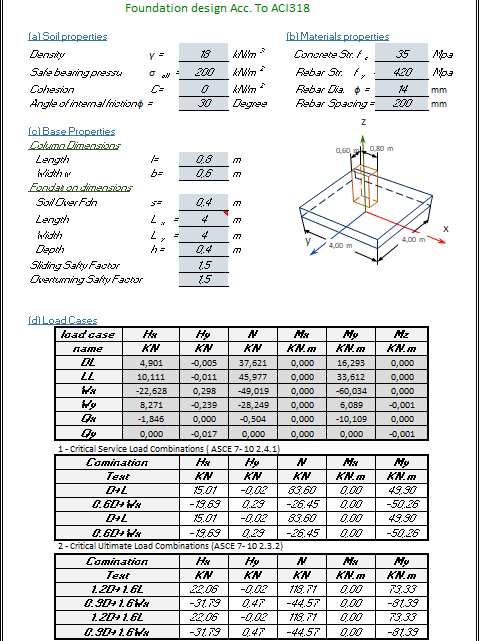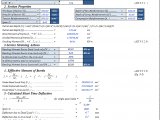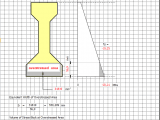
Foundation Design Spreadsheet As Per ACI 318
18 July 2025Foundation Design Spreadsheet As Per ACI 318
The foundation is the unsung hero of any structure, the critical interface transferring building loads safely to the underlying soil. For concrete foundations, adherence to the American Concrete Institute (ACI) 318 Building Code Requirements for Structural Concrete is paramount. This article serves as an SEO-focused guide for civil engineers navigating the principles of foundation design as per ACI 318, emphasizing key considerations for a robust and compliant structure.
Why ACI 318 Reigns Supreme in Concrete Foundation Design
ACI 318 is the cornerstone of concrete structural design in the United States and is widely adopted internationally. Its comprehensive guidelines ensure the safety and serviceability of concrete structures, including foundations. Following ACI 318 in foundation design provides numerous benefits for civil engineers:
-
Ensuring Structural Integrity: ACI 318 outlines rigorous procedures for strength design, ensuring the foundation can safely resist all anticipated loads.
-
Compliance with Building Codes: Most local building codes directly reference and require adherence to ACI 318.
-
Industry Best Practices: ACI 318 embodies decades of research, experience, and consensus within the structural engineering community, representing the current best practices for concrete foundation design.
-
Clear Guidelines for Materials and Construction: The code specifies requirements for concrete materials, reinforcement, and construction practices essential for durable and reliable foundations.
-
Guidance on Various Foundation Types: While geotechnical investigations dictate the most suitable foundation type, ACI 318 provides design requirements for common concrete foundations such as spread footings, wall footings, slabs-on-grade, and pile caps.
Key Principles of Foundation Design per ACI 318
Designing concrete foundations according to ACI 318 involves a multi-faceted approach integrating principles of structural engineering and geotechnical considerations. Here are some key principles:
-
Accurate Load Determination: The first crucial step is to accurately determine all the loads that the foundation will need to support. This includes dead loads (weight of the structure itself), live loads (occupancy loads, furniture, etc.), wind loads, seismic loads, and any other relevant forces as dictated by the building code and the structure’s use. ACI 318 provides guidance on load factors for strength design.
-
Geotechnical Investigation is Paramount: While ACI 318 focuses on the structural design of the concrete foundation, it fundamentally relies on a thorough geotechnical investigation. This investigation provides critical information about the soil bearing capacity, settlement characteristics, groundwater conditions, and other soil parameters that dictate the foundation type and allowable bearing pressures. Civil engineers must collaborate closely with geotechnical engineers.
-
Selection of Appropriate Foundation Type: Based on the geotechnical report and the structural loads, the appropriate foundation type is selected. Common concrete foundations covered implicitly or explicitly by ACI 318 include:
-
Spread Footings: Individual footings supporting columns.
-
Wall Footings: Continuous footings supporting walls.
-
Slabs-on-Grade: Concrete slabs resting directly on the prepared ground. ACI 318 Chapter 14 addresses wall foundations, which often include footings.
-
Pile Foundations and Pile Caps: Used when the bearing capacity of shallow soils is insufficient. ACI 318 Chapter 13 provides requirements for bearing strength and Chapter 15 covers footings, including those supporting piles or drilled shafts.
-
-
Strength Design Philosophy: ACI 318 employs a strength design (also known as Load and Resistance Factor Design – LRFD) philosophy. This involves:
-
Factoring Loads: Multiplying service loads by load factors to account for uncertainties in load magnitude.
-
Reducing Strengths: Multiplying the theoretical strength of the concrete and reinforcing steel by strength reduction factors (Φ) to account for uncertainties in material properties, construction tolerances, and potential failure modes.
-
Ensuring Design Strength Exceeds Required Strength: The design strength (Φ * nominal strength) of the foundation component must be greater than or equal to the required strength (sum of factored loads).
-
-
Design for Flexure, Shear, and Bearing: Concrete foundations must be designed to resist bending moments, shear forces, and bearing pressures transferred from the supported structure and onto the soil. ACI 318 provides detailed equations and requirements for calculating these stresses and designing the necessary concrete dimensions and reinforcement.
-
Flexure: Design of reinforcement to resist bending moments, particularly in footings extending from columns or walls.
-
Shear: Ensuring adequate concrete section or shear reinforcement to resist shear forces.
-
Bearing: Checking that the bearing pressure on the soil does not exceed the allowable bearing capacity provided by the geotechnical report and ensuring adequate bearing strength between the supported member and the foundation.
-
-
Serviceability Considerations: While strength is paramount, ACI 318 also implicitly addresses serviceability through limitations on deflection (though less critical for typical foundations compared to beams and slabs) and crack control through reinforcement detailing. Excessive settlement, a key serviceability concern for foundations, is primarily addressed through geotechnical investigations and adherence to allowable bearing pressures.
-
Reinforcement Detailing: Proper detailing of reinforcing steel is crucial for the performance of concrete foundations. ACI 318 provides specific requirements for:
-
Minimum reinforcement ratios: Ensuring a minimum amount of steel to prevent brittle failure.
-
Bar spacing: Limiting the spacing to control cracking.
-
Cover requirements: Providing adequate concrete cover to protect the reinforcement from corrosion.
-
Development length and splices: Ensuring proper anchorage and transfer of stress between the reinforcement and concrete.
-
-
Durability Considerations: ACI 318 addresses durability through requirements for concrete mix design, exposure categories, and protection of reinforcement, ensuring the foundation’s long-term performance in its specific environment.


